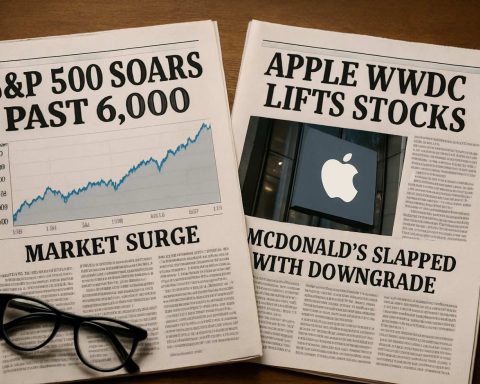- UK retail, particularly non-food sectors, struggles with sluggish sales despite a 1.1% growth in overall retail.
- Current growth lags behind the three-month average of 2.4% and barely exceeds the 12-month average of 0.8%.
- Retailers face a looming £7 billion in new costs due to forthcoming budget changes and a packaging levy by 2025.
- The Employment Rights Bill may further strain workforce management.
- Retailers must balance rising operational costs with competitive pricing, risking investment cuts and job impacts.
- Consumers may see fewer deals and experience changes in shopping habits due to economic pressures.
- Adaptive strategies are vital for retailers to weather the economic challenges and thrive in a hopeful spring renewal.
Amid the muted hum of bustling British high streets, a chill seems to linger—a shadow cast not by the cozy end-of-winter breeze, but by figures that reveal a troubling truth: UK retail, particularly in the non-food sector, is feeling the economic frostbite. As February’s drizzly clouds loomed over the nation, fashion retailers found themselves trudging through a month hampered by sluggish sales. The latest data from the British Retail Consortium (BRC) paints a nuanced picture: while overall retail sales saw a modest rise of 1.1% compared to the previous year, this increase merely echoed the same growth rate as February 2024, offering little solace.
The figures are particularly stark when measured against the three-month average growth of 2.4% and shine only slightly brighter than the 12-month average of 0.8%. This tepid performance comes as a bitter pill for retailers already grappling with the pressures of an evolving commercial landscape.
Adding to this conundrum is the ominous shadow of £7 billion in new costs set to sweep across the retail horizon by 2025, thanks to upcoming changes in the Budget and a looming packaging levy. Retailers feel the strain, caught in a tightrope walk of balancing rising operational expenses without alienating customers with price hikes. The drums of economic challenge beat louder with the Employment Rights Bill potentially altering the rhythm of workforce management.
In this landscape, the industry faces crucial decisions: continue absorbing costs while squeezing margins, or begin a delicate dance with pricing strategies that might deter the very customers they hope to retain. The latter could mean not only increased prices but also difficult cuts in investment—impacting both jobs and the vibrant storefronts that dot the UK’s towns and cities.
For the consumer, these developments present a sobering realization. The familiar experience of leisurely browsing a well-stocked fashion rack or snagging an affordable deal might become a memory tinged with the awareness of economic pressures. As individuals, communities, and businesses adapt, the retail sector’s resilience will be put to the test.
As clouds gather on the fiscal horizon, the critical takeaway remains clear: UK retailers must navigate turbulent waters with shrewd strategies and adaptable plans, ensuring they emerge from this economic winter into brighter, more prosperous days. Spring, after all, is the season of renewal—and it promises hope for those strategically prepared to embrace it.
UK Retail Sector Faces Economic Challenges: What You Need to Know
The UK retail landscape, particularly the non-food sector, is grappling with the “economic frostbite” as sluggish sales in February reveal deeper economic concerns. In this comprehensive analysis, we delve into the pressing issues affecting UK retail and provide valuable insights and actionable recommendations.
Economic Overview: Key Facts and Figures
1. Retail Sales Growth: While overall retail sales marginally increased by 1.1% compared to the previous year, this mirrors February 2024’s growth and pales compared to the three-month average growth of 2.4%.
2. Rising Costs: The industry braces for an additional £7 billion in costs by 2025 due to changes in the Budget and a new packaging levy. This financial strain is compounded by uncertainty surrounding the Employment Rights Bill.
3. Operational Challenges: Retailers face the conundrum of rising operational expenses, requiring them to balance cost absorption against necessary price increases—a delicate equilibrium to maintain consumer loyalty without sacrificing profitability.
Retail Industry Trends and Forecasts
– E-Commerce Growth: As physical retail spaces face challenges, online sales are poised to continue their upward trajectory, encouraging retailers to invest in digital platforms and omnichannel strategies.
– Sustainability and Innovation: With the packaging levy as a catalyst, the trend towards sustainable practices is likely to accelerate. Retailers focusing on eco-friendly products and circular business models will be well-positioned for future success.
– Shifts in Consumer Behavior: As price consciousness grows, value retailers and discount stores may see increased footfall. Tailoring offerings to meet the demand for affordable yet quality options will be critical.
Real-World Use Cases and Strategies
– Dynamic Pricing Models: Implement intelligent pricing strategies that adjust in real-time based on market demand, consumer behavior analytics, and competitor pricing.
– Workforce Management: Leverage technology to optimize workforce scheduling and maintain customer service standards amidst staffing cost pressures, as potential legislative changes come into play.
– Customer Engagement: Invest in targeted marketing campaigns and personalized experiences to retain loyalty. Developing a strong brand narrative that aligns with consumer values can foster deeper connections.
Challenges and Limitations
– Rising Inflation: Continued inflationary pressures could exacerbate financial challenges for retailers, affecting both supply chain costs and consumer purchasing power.
– Brexit Implications: Ongoing trade negotiations and changes in trade agreements post-Brexit present uncertainties regarding supply chain operations and costs.
Pros & Cons Overview
Pros:
– Potential growth in e-commerce offerings.
– Opportunity to innovate with sustainable practices.
Cons:
– Rising operational costs.
– Potential impact of legislative changes on workforce management.
Actionable Recommendations
1. Embrace Digital Transformation: Accelerate investment in digital platforms and adopt omnichannel strategies to enhance customer reach and experience.
2. Focus on Sustainability: Seek out and promote sustainable practices and products, aligning with consumer preferences for environmentally conscious options.
3. Innovate Workforce Solutions: Use technology to manage workforce efficiently and prepare for potential legislative changes.
4. Optimize Pricing Strategies: Implement dynamic pricing models that align with market demand and consumer spending patterns.
Conclusion
As UK retailers face mounting economic pressures, strategic adaptation and proactive planning are crucial. By leveraging digital innovation, emphasizing sustainability, and maintaining a sharp focus on customer engagement, the retail sector can navigate these challenges and anticipate a brighter, more prosperous future.
For more insights into the retail industry, visit the British Retail Consortium.













